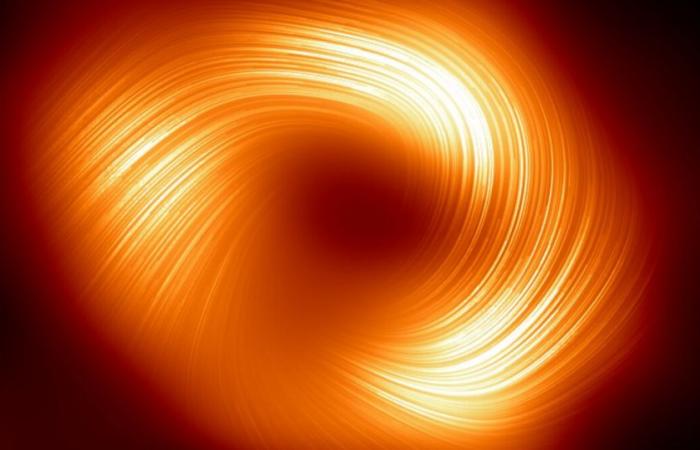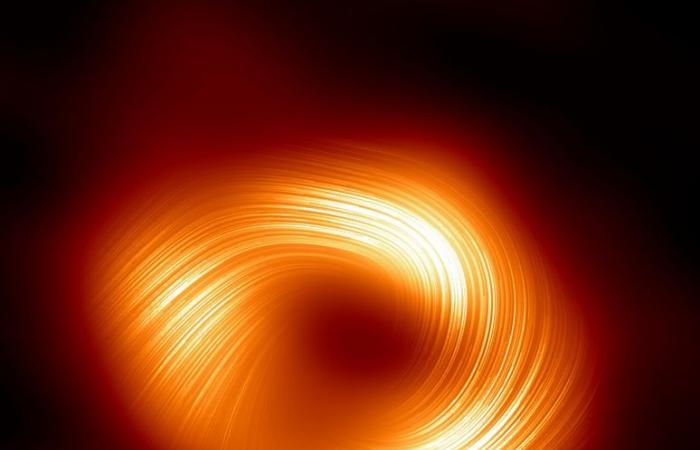A supermassive black hole suffered a hiccup after having its accretion disk punctured by a smaller companion
At the heart of a galaxy 800 million light-years away, a supermassive black hole is “sobbing.” The previously inactive object now emits gas plumes every 8.5 days before returning to normal. The surprising cause is that a second black hole is “puncturing” the object’s accretion disk.
Photo: NASA/Caltech/R. Hurt (IPAC) / Canaltech
The supermassive black hole was discovered in December 2020 and appeared similar to others of its type. However, 52 days later, the Neil Gehrels Swift instrument (Swift) detected X-rays coming from the region, leading scientists to monitor this activity with the NICER X-ray telescope.
They found that the radiation burst lasted about four months, showing a pattern of subtle, periodic dips every 8.5 days. Interestingly, the phenomenon resembled the light flickers when observing a planet passing in front of its host star, briefly blocking its light.
As it is a gigantic black hole with a brightness equivalent to a galaxy, scientists were confused, as there is no mechanism in theory that could cause this effect. But theoretical physicists in the Czech Republic had an idea: perhaps there is a second black hole passing in front of the first, just like a planet passing in front of a star.
The Czechs’ proposal was published in an independent article and was found by the authors of the new study, led by Dheeraj “DJ” Pasham, a scientist at the MIT Kavli Institute (MKI) for Astrophysics and Space Research. “I was super excited about this theory and immediately emailed them and said, ‘I think we’re seeing exactly what your theory predicted,'” says Pasham.
So scientists from both teams came together to create simulations based on NICER’s observations of the supermassive black hole explosion and 8.5-day oscillations. The results support the idea of a binary system, with a smaller black hole orbiting the larger one and traversing its accretion disk from time to time.
The accretion disk is the light we see in images of black holes (Image: Reproduction/EHT Collaboration)
Photo: Canaltech
The accretion disk of a black hole is formed by hot plasma rotating at very high speed around it, producing energy and emitting electromagnetic radiation in various types of wavelengths. It is this disk that appears in illustrations and in real images of black holes.
Before the explosion, the main black hole had a faint accretion disk, while the second black hole orbited it without attracting attention. The suspicion is that this apparently harmonious system was disturbed by a third object in 2020, probably a nearby star.
When it got close enough, the star was torn apart by the supermassive black hole, creating a sudden outflow of material that lit up the accretion disk. Over the course of four months, the supermassive object fed on this material, while the second black hole continued its orbit.
Over the course of four months, the second black hole punctured this disk as it traveled its routine orbit, resulting in a larger-than-usual ejection. Simulations suggest this may be a new type of system, dubbed “David-Goliath.”
The researchers claim that this is a phenomenon that has never been observed before, contradicting traditional models about these systems, and suggests that there is a large population of similar pairs in the universe.
Finally, the mass of the secondary black hole also draws attention: it is estimated between 100 and 10 thousand solar masses, in contrast to 50 million for its supermassive black companion. This means it is an intermediate-mass black hole, something scientists have been trying to find for decades.
The research was published in the journal Science Advances.
Source: EurekAlert, ScienceAdvances
Trending on Canaltech:
+The best content in your email for free. Choose your favorite Terra Newsletter. Click here!







